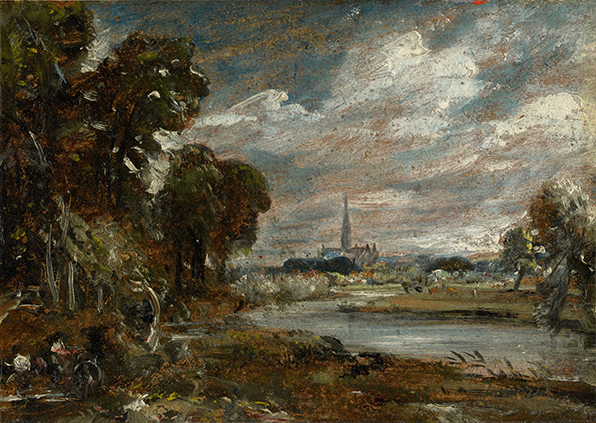
DECEMBER 15, 2018–MARCH 10, 2019
ABOUT THE MANTON COLLECTION
John Constable (English, 1776–1837), Salisbury Cathedral from the River Nadder, c. 1829. Oil on beige wove paper, mounted on laminate cardboard. Clark Art Institute. Gift of the Manton Art Foundation in memory of Sir Edwin and Lady Manton, 2007.8.46
The Manton Collection of British Art at the Clark Art Institute is considered one of the greatest collections of British art assembled in the last fifty years. Highlights of the collection include John Constable’s contemplative views of the English countryside and strikingly naturalistic oil studies; Joseph Mallord William Turner’s turbulent, quasi-abstract seascapes; Thomas Gainsborough’s rigorous chalk drawings; and Thomas Rowlandson’s humorous watercolors caricaturing British life. The collection includes more than 300 works and features great suites of watercolors, drawings, and prints by such artists as Thomas Girtin, Richard Parkes Bonington, Samuel Palmer, John Martin, and William Blake.
The collection was created by business leader and arts patron Sir Edwin A. G. Manton (1909–2005) and his wife Florence, Lady Manton (1911–2003), who began collecting in the 1940s. Born in Essex County, just twenty miles from “Constable Country” in the east of England, Sir Edwin arrived in New York in 1933 to help develop the American International Group. Although he spent the remainder of his life in the United States, his love of British art was testimony to his continued devotion to his native country.
Sir Edwin was knighted by Queen Elizabeth in 1994 for his generous contributions to the Tate Gallery (now Tate Britain) in London. Throughout his life, his appetite for art collecting never diminished. “I am a compulsive buyer,” he once observed. “It's better than spending your money on bottles of Scotch.” This collection, a gift from the Manton Foundation in 2007, constitutes the most significant addition of art to the Clark since it was founded in 1955 and perfectly complements the Clark’s holdings of nineteenth-century French and American art.

